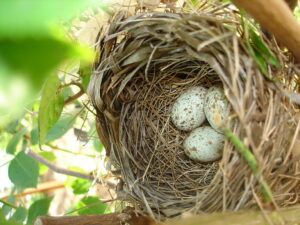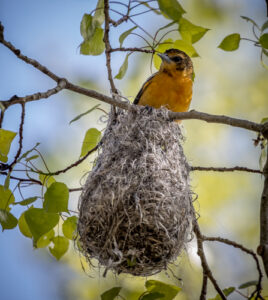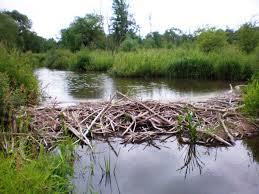This week’s Nature Kits focus on sticks. Even though we often overlook them, sticks are important parts of habitats. Sticks can be used for habitats or homes and can also be hosts for small organisms like moss and lichen.
Every Saturday, nature kits are given out on a first-come, first-served basis from 10:00 am-12:00 pm. Nature kits focus on a different theme each week and are meant to be done along our trails and given back once completed. If you can’t make it out to the Center to pick up a kit, make sure to check our blog each week for ways to get in some nature exploration at home.
Activity #1: Stick Scavenger Hunt
Sticks are different from branches. A branch is connected to a tree. Large branches are called boughs and small branches are called twigs. Sticks are branches that are no longer connected to a tree and are on the ground.
- Go on a walk in your backyard or at a nearby park.
- Use the stick scavenger hunt to find sticks in different shapes and sizes.
- Since sticks can be used for homes or habitats, it is best to leave them where we found them. You can, however, use a camera to take a picture of the different types of sticks that you find.
- Check the items you find off on your scavenger hunt sheet as you go along.
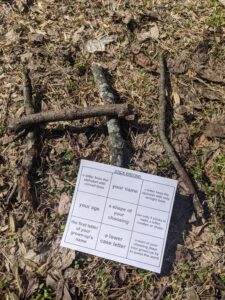 Activity #2: Stick Writing
Activity #2: Stick Writing
- Collect sticks large and small and use them to make different shapes, letters, and numbers. Some ideas for what to make include:
- A letter from the alphabet with curved lines
- A letter from the alphabet with straight lines
- The first letter or your name or, if you have enough sticks, your entire name
- The number that corresponds with your age
- A shape with straight lines
- Using only four sticks to make a letter, number, or shape
- What was the easiest shape, letter, or number to make with sticks?
- What was the hardest?
- Remember to put the sticks back where you found them once you are finished.
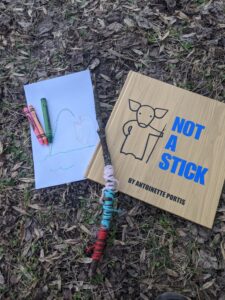 Activity #3: Not Just a Stick
Activity #3: Not Just a Stick
- In her book Not a Stick, Antoinette Portis talks about all the things that sticks can be if you just use your imagination.
- A stick can be a fishing pole catching a shark, a paintbrush for painting a masterpiece, or even a wand for casting spells.
- Listen to the reading of the book here.
- Find a stick outside to use as inspiration.
- Then grab a piece of paper and some crayons and use your imagination to draw some other unique things that sticks can be. Have your grown-up try to think of some ideas as well.
Activity #4: Habitat Building
Animals such as birds, beavers, and squirrels will use sticks to build their homes or nests. Squirrels and certain types of birds will start building their nests by weaving grass and twigs together. They will then line their nests with soft materials such as leaves or moss. Use the guidance below to try to make a bird nest and a beaver dam using sticks.
Bird Nest
Birds will use their beaks to carry small sticks and twigs to their nesting locations. They will weave the sticks together with other soft materials such as grass, moss, and leaves to make a cup shape.
- Use your pointer finger and thumb as a beak and move natural materials to your nest site similar to how a bird would.
- Once you have all of your materials, try weaving them together to make a nest, using the picture below as a guide.
- Nests are easy to see in the winter when the trees are bare.
- Do you see any nests in the trees?
- Squirrel nests or dreys are particularly easy to find, and they typically look like large bundles of leaves.
- Do you see any squirrel nests in the trees?
Beaver Homes
Beavers build dams in order to create small ponds in which they then build their homes. They make these dams by using large sticks.
- Find a medium to large sized rubber maid and use sticks to make a dam in the middle.
- Once your dam is constructed, slowly pour water onto one side of the rubber maid.
- Did most of the water stay on the side where you poured it?
- If so, you’ve created a successful dam!
- If not, empty out the water and try to reconstruct your dam before trying again.
- Did most of the water stay on the side where you poured it?
- If you don’t have a rubber maid at home, you can also try this experiment by digging a small gully outside.
- Make sure to fill the gully back in once finished.

